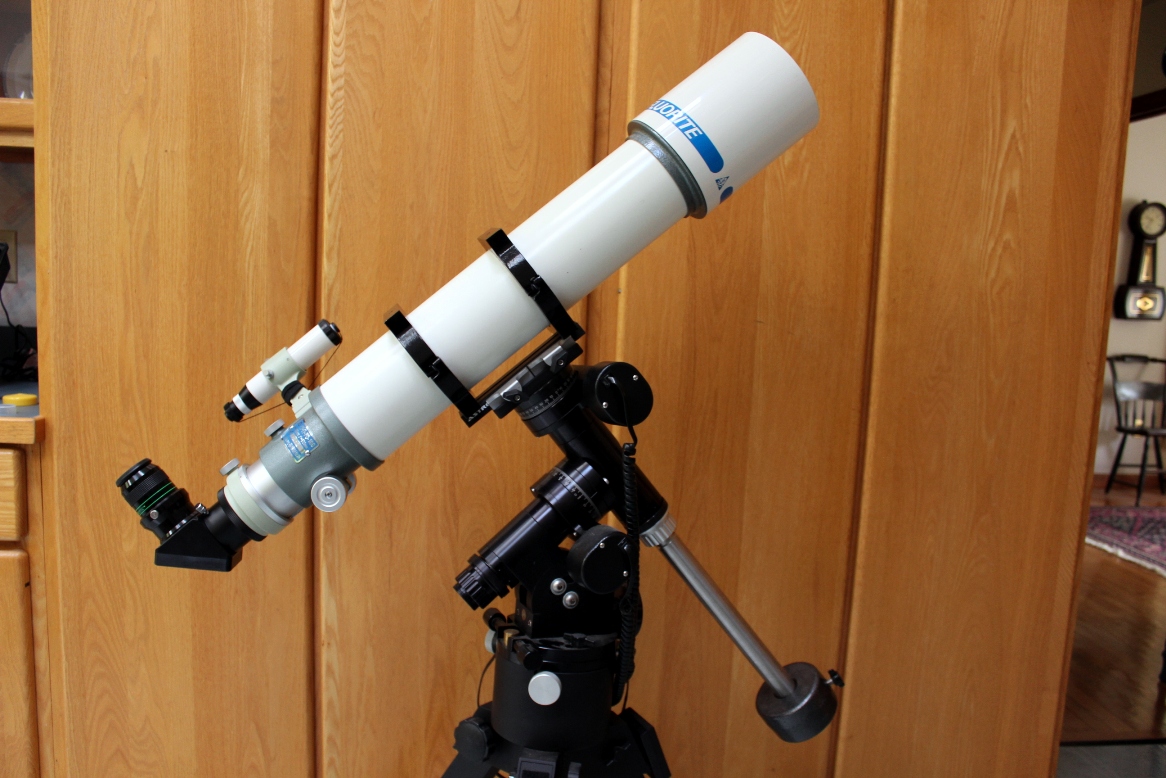
Updated 5/12/13, 9/22/13
1) Takahashi FC100 (2nd Review, 2013) 5/12/13
2) Takahashi Teegul-60 9/22/13
(100 mm f/8 apochromatic refractor OTA, NLA, replaced by FS102, 102NSV, and TSA102)
I recall a conversation with an old Physics professor:
"Son (he called everyone Son) - you want the least amount of JUNK between you and the sky."
He scribbled a diagram of a Schmidt-Cassegrain on a notepad. "Now you take this here Schmidt-Cassegrain. You got a corrector plate, a primary mirror, a secondary mirror, and a diagonal. That's four pieces of JUNK and we haven't even gotten to the eyepiece yet." He tore off the sheet of paper, wadded it up, and tossed it on the ground. It is fair to say, he was not a fan of Schmidt-Cassegrains.
On top of the next piece of paper he drew a diagram of a reflector. "Now on this here Newtonian reflector, you got a primary mirror and a secondary mirror. That's two pieces of JUNK, and one of 'ems, obstructing the other one." He wadded up this piece of paper (although with slightly less vigor than before) and tossed it on the ground.
On the third piece of paper he drew a ray trace diagram of a refractor. "Now notice how simple this drawing is. You only got one piece of JUNK between you and the sky. The lens - that's it."
He turned towards me and pointed a finger meaningfully at me. "For this reason, and this reason alone, the only astronomical telescope you should ever consider using is a refractor."
There are other reasons, of course, but no other kind of telescope garners the kind of fanaticism that good refractors do (OK, maybe you Questar people belong in this company too.) When someone shows up in the observing field with one, everyone stops and turns to look. For myself, after flirtations with all kinds of different telescopes, I always wind up going back to refractors. It feels like coming home.

Takahashi's amazing FC100
Enter the Takahashi FC100. My old Physics professor would approve. Like other refractors, it only has one piece of JUNK between you and the sky. Although, if you've ever looked at a Takahashi lens cell, JUNK is the last word that will come to mind. Takahashi lens assemblies are works of art. I sold my beloved FS102 years ago and I've regretted every moment of it since. I always vowed I'd get another one, but you know how it is. Life got in the way. After ten long years, I finally decided I was going to stop messing around and I'd get another one. But my - how things had changed in those ten years! The FS102 was replaced by the NSV (New Short Version) and the TSA102. Alongside these models were the TOA130 and the FSQ106. And the new prices were breathtaking. Luckily, I found one of the older FC100s on Astromart and jumped on the deal.
These older FC100 scopes had the fluorite element in the rear (newer models have them in the front.) The FC models include the FC50, FC60, FC76, FC100, FC125, and FCT150. All are desirable and are becoming increasingly rare on the used market. Of all the models, the FC76 seems to be the most common, and even these simple 3" OTAs go for upwards of $1200. There is a lot of debate about old vs new, with many astronomers preferring the older FC models, which are said by some to have superior contrast. This, coupled with their rarity, has bestowed a cult-like following for these FC models. I first visited this model back around the year 2000 (brief review here) in Arizona when some club members visited an astronomy bed and breakfast.
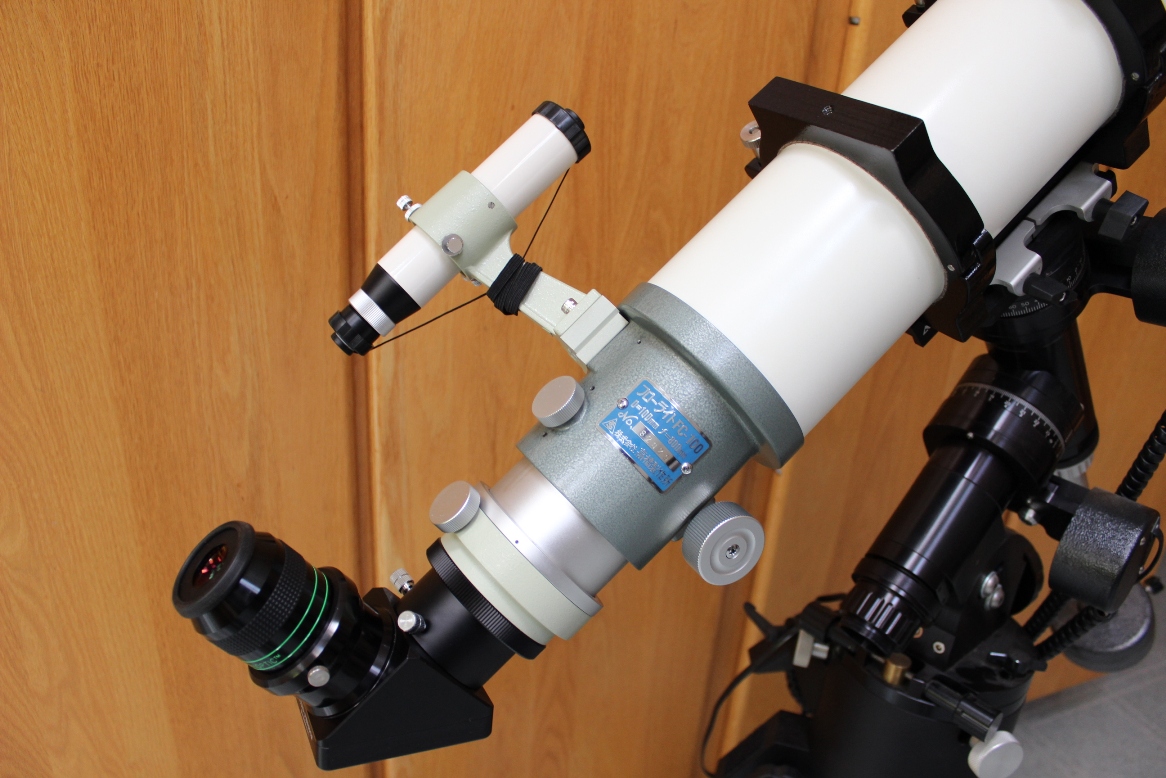
Close up of focuser and 6X30 finder
When the FC100 arrived on my doorstep, I sent an email to the seller thanking him for selling it to me. Then, I drove over to club member Mike T's house. Mike, who loves refractors more than life itself, immediately took it out of my hands and mounted it on his CG-5 outside. Suddenly relieved of anything to do, I sat at the kitchen table and talked to his wife and son. After a while, I wandered outside and found Mike at the scope with a set of University Optics Orthos. I am paraphrasing here, but here are his comments (in no particular order):
"Ooohhhh....."
-and-
"This is so good it should be illegal."
-and-
"When are you going to sell it to me?" (three times)
We spent some time looking at Jupiter, and I had to admit, the scope is a killer. It seemed to soak up magnification and every bump in power seemed to reveal more detail. The seeing that night was quite steady, and the planet stayed tight and planted in the eyepiece. The star test was nearly perfect, but did reveal a tiny bit of the anomaly described in the AP175 review on the previous page (I am now taking this as a good sign.) There was a -tiny- trace of false color when we bumped it up to stupid-high powers that no one would ever use.
When Mike T was done with it, the scope went north to Old Dan's place near Concord NH. Dan reported splitting Sirius with it. I am impressed. This feat is nearly impossible up in NH because the star is always so low in the sky, and because we rarely get seeing good enough to split this elusive double. Having a good scope like the FC100 helped.
After a couple of months, I actually got to take possession of my telescope. I've used it on my GM-8 and my CG-5; both mounts hold the scope well. It is an interesting time of the year for planetary observing right now, with Jupiter setting in the west just as Saturn is rising in the east. You aren't sure which one to look at. All the times I've had it out have only verified my initial impression. The scope is a KILLER. Under good conditions, you can just keep pushing the power; the mount usually gives out before the optics do. But most of the time, I found myself just enjoying the views of Saturn with the 7 mm Nagler, and the 6 mm and 5 mm TMB Super Planetary eyepieces (the latter are excellent values, by the way.) Switching to low power with the 26 mm Nagler, I spent some time looking at the winter clusters for the last time this year - M35, M37, M36, and M38. M81 and M82 are nicely framed in the 26 mm Nagler, as are M65/M66/NGC3628 in Leo.
If my house were on fire, this would be one of the first things I'd grab on the way out.
2) Takahashi Teegul-60 9/20/13
(60 mm f/8.33 apochromat, Teegul alt-az mount, NLA)
You want obscure? You've come to the right place! I saw this on Astromart one day and it stopped me in my tracks. I thought I knew a lot about Takahashi lore, but I'd never seen anything like this in my life. Despite having big bills to pay around the house, I immediately responded to the seller (I tried not to look too hard at the price.) When it arrived about a week later, I set it up in the living room and just stared at it. This may be the strangest telescope I've ever reviewed.
Manufactured in the early 1990s, the Teegul 60 was part of a trio of scopes made by Takahashi for the Japanese market. Information is scarce, but the others in the series included 100 mm f/7.7 and a 150 mm f/5.7 scopes, apparently in a modified Cassegrain-Dall Kirkham configuration. All three were sold with a Takahashi's alt-az Teegul mount. Note that this is not a conventional FC-60 mated with a regular Teegul mount; closer inspection reveals that both the OTA and mount are custom made, and made to work together. Like many alt-az mounts, there is a dead spot near the zenith. In late summer, I could not observe Deneb or Vega, for example. Check out the beautifully tapered aluminum tube on the back end. The focuser is helical, with both a rough focus (draw out the whole tube and clamp it) and a fine focus - the arrangement is similar to the old TeleVue Ranger. The drawtube is marked with distances, and has charming drawings like mountains and stars on it. There's a position marking on it if you plan to use a diagonal. The clamp on mine is spelled "CLUMP." Unlike modern Takahashis, the finder stalk is integral to the OTA. In keeping with the light weight philosophy, the lens cap is a simple piece of plastic. The lens cell has no collimation screws or adjustments of any kind.
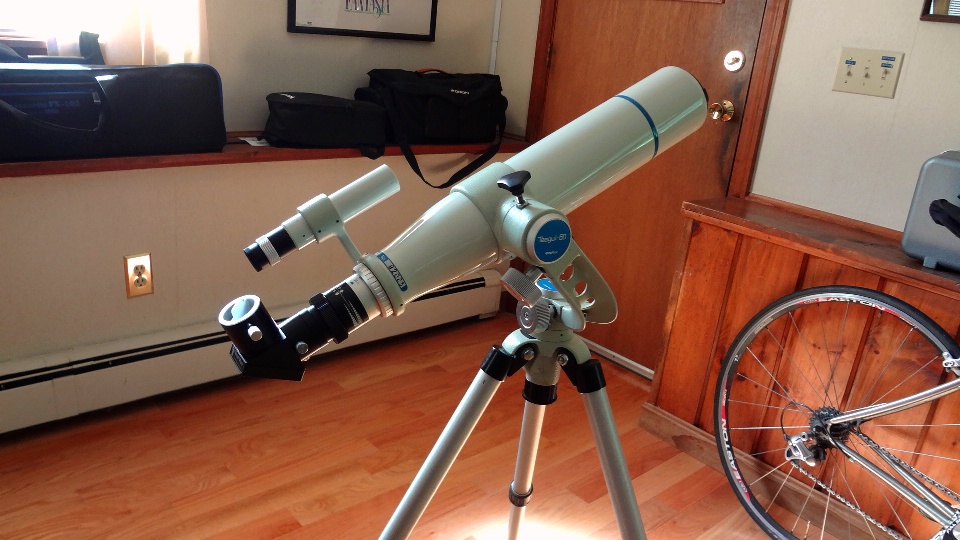
Takahashi's Teegul 60 (TeleVue diagonal installed. Unlike new Taks, the lime green pieces are steel, not cast iron.
This model was made before Takahashi went crazy with the cast iron. Although the lime green pieces look like the new cast iron Tak parts, they're actually steel, painted green. As a result, the OTA weighs next to nothing, a refreshing change from the bulky doorstops of modern Takahashis. The Teegul's integral tube ring is also steel, and clamps (or "CLUMPS?") shut with a simple friction fit; there are no hinges. Strange, eh? To emphasize that it's a system, "Teegul-60" is printed on the mount itself. There's a threaded black cap on the bottom of the mount that doesn't seem to do anything; club members surmised that it's for hanging weights to stabilize the system.
And it turns out that stabilizing the mount is the biggest issue with the scope. The whole assembly is so light - a kid can easily pick it up with one hand - that any bumps, including using the focuser, will cause the image to jiggle. I'm planning on mounting the OTA on my NexStar or CG-5, but -can you believe this- it's really hard to find 80 mm ID rings these days.
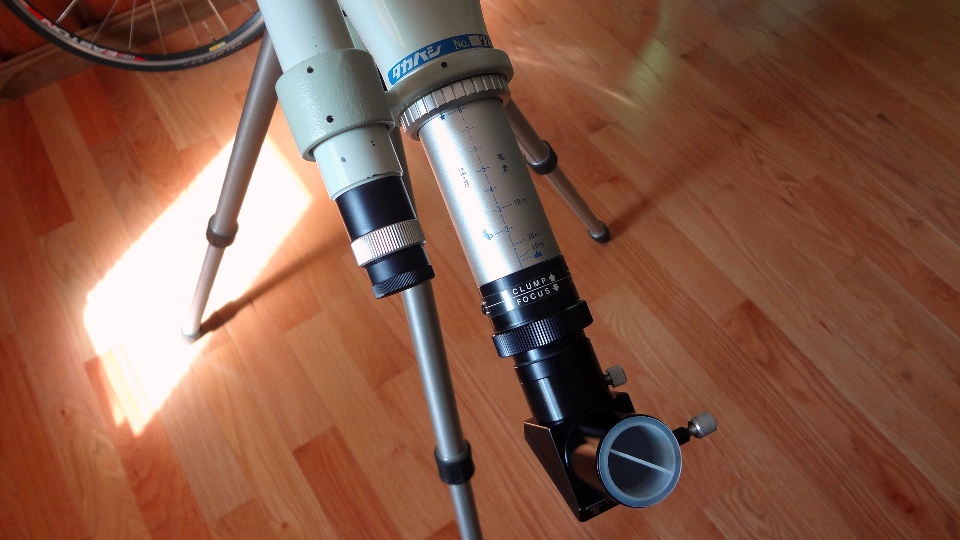
Drawtube has helpful markings on it. The clamp is labeled "CLUMP"
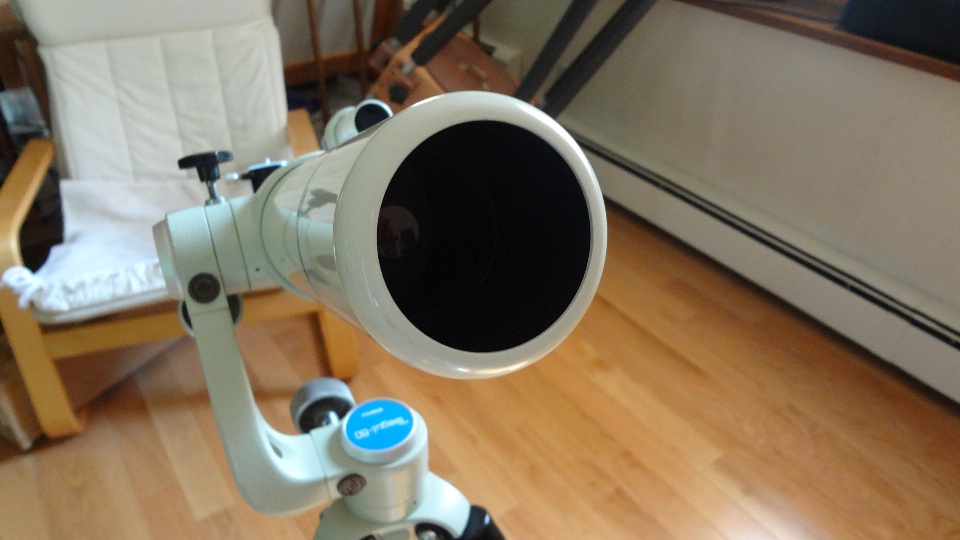
No collimation screws, no retracting dew shield
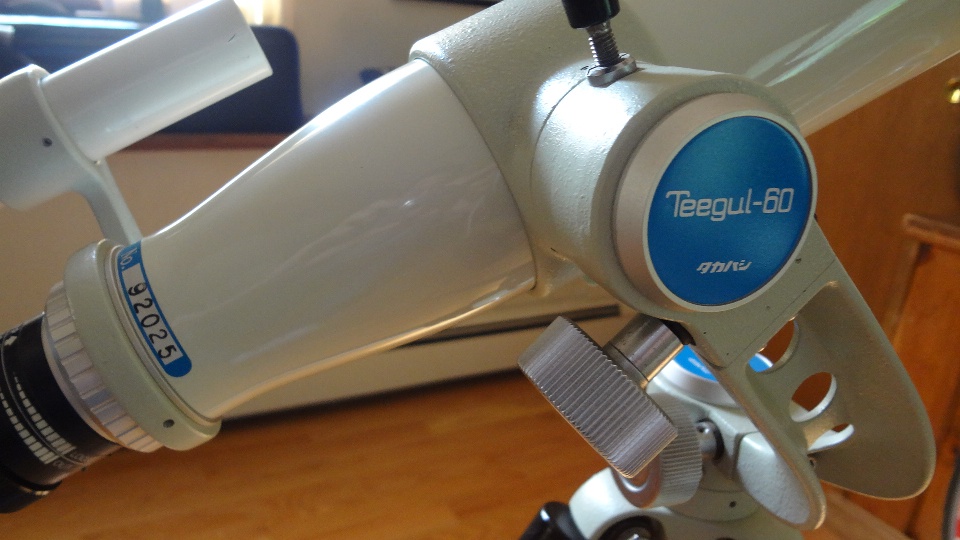
Finder stalk attaches to tube via a ring. Note the "Teegul-60" logo on the mount.
How are the optics? Outstanding. There's only a trace of spherical aberration, and almost no false color. There's a tiny fringe of purple (if you know where to look) on the limb of the moon, or around bright stars like Vega. How many 20+ year old refractor designs can you name that are still competitive today? The Teegul mount is the limiting factor, and will keep you under 100X for the most part, but for a casual quick-peek scope, 100X is more than enough. The scope's superb contrast allows for deep sky work that might not be possible with lesser refractors. In the summer sky, I had no trouble picking out M81 and M82, for instance. The Dumbbell, Albireo, M13, M92, and M3 are no problem. Even from my light polluted magnitude 4 skies in southern NH, I could just manage to see M65 and M66 with a 7 mm Nagler (71X.) Once I get the optical tube properly mounted, I'm going to try some imaging with it.
I took the scope to a skywatch at the local planetarium. You want to know one advantage of bringing a small scope to a public skywatch? People tend to leave you alone. They generally gravitate to the biggest scope they can find, leaving you in peace to observe. In late summer, under light polluted conditions, I had no trouble finding M8, M22, and M20, barely above the horizon. One person, who knew nothing about telescopes, told me that the view of Albireo was the best he'd seen that night. Chalk it up to that contrasty, sharp refractor magic.
An amazing scope, a solid performer, and a collector's item. The only problem is, now I want more of these old Takahashis - can my savings account handle this?